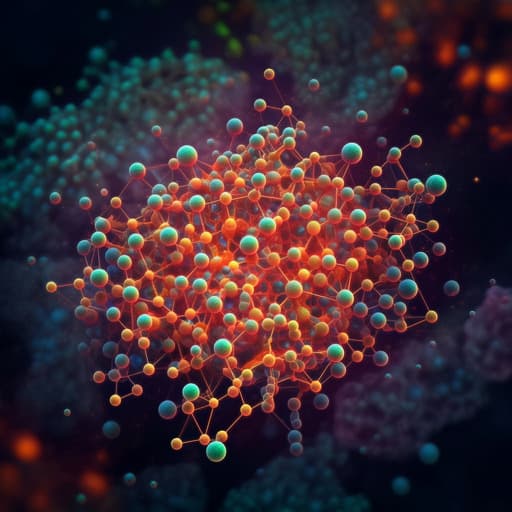
Medicine and Health
LRP1B mutation is associated with tumor immune microenvironment and progression-free survival in lung adenocarcinoma treated with immune checkpoint inhibitors
Z. He, W. Feng, et al.
This groundbreaking study reveals that LRP1B mutations in lung adenocarcinoma patients can enhance their response to immune checkpoint inhibitors, leading to better clinical outcomes. Conducted by Ziyi He and colleagues from the Department of Thoracic Surgery, The First Affiliated Hospital of Soochow University, this research showcases LRP1B mutation as a promising prognostic biomarker.
~3 min • Beginner • English
Introduction
Lung cancer is one of the world’s most lethal cancers, and lung adenocarcinoma (LUAD) accounts for over 40% of cases. Despite advances in targeted therapy, 5-year survival for LUAD remains below 20%. Surgery is primary treatment, yet even stage I patients experience significant recurrence. While adjuvant chemotherapy can improve survival, toxicity may limit benefit for some patients. Immunotherapy, particularly immune checkpoint inhibitors (ICIs), has changed LUAD prognosis by producing durable responses. Clinically used biomarkers such as tumor mutational burden (TMB) and PD-L1 have limitations including tumor spatial heterogeneity, subjective PD-L1 assessment, and lack of standardized TMB thresholds. The response to ICIs depends on interactions within the tumor immune microenvironment (TIME), a complex spatial structure comprising diverse immune and stromal cells. Both immune and stromal components influence ICI response. LRP1B, a low-density lipoprotein receptor-related protein often inactivated in NSCLC and postulated as a tumor suppressor, has been associated with improved outcomes after immunotherapy across multiple cancers and with higher TMB. However, mechanisms linking LRP1B mutation to improved immunotherapy outcomes remain unclear. The authors hypothesize that LRP1B mutation in LUAD positively modulates the TIME, thereby improving outcomes in ICI-treated patients.
Literature Review
Methodology
Study design and cohorts: An ICIs-treated LUAD cohort (n=59) receiving PD-1 plus CTLA-4 blockade from a prior study was analyzed to assess prognostic associations with LRP1B mutation. Clinical data included age, sex, treatment response, neoantigen load (NAL), tumor mutational burden (TMB), and mutation types. Patients were categorized as LRP1B-mutated (MT; n=15) or wild-type (WT; n=44). A TCGA-LUAD cohort (n=507 after excluding missing data) with transcriptome, somatic mutation, and survival data (OS, PFS) was obtained via TCGAbiolinks and cBioPortal to investigate genomic and TIME differences by LRP1B status.
Genomic analyses: Whole-exome sequencing provided somatic mutations for the 59 ICIs cohort patients. TMB was defined as nonsynonymous mutations per megabase in coding regions. NALs and immune scores were from prior publications. LRP1B mutation frequencies, types, and domains came from cBioPortal. Maftools summarized top mutated genes and clinical features; ComplexHeatmap depicted gene mutation co-occurrence/exclusivity. Copy number variation in TCGA-LUAD was analyzed using GISTIC 2.0 (CI=0.99; excluding X chromosome) from Affymetrix SNP 6.0 data via Broad GDAC Firehose.
TIME and transcriptomic analyses: CIBERSORT estimated the relative abundance of 22 immune cell types from TCGA-LUAD transcriptomes. Expression of immune-related genes (antigen processing/presentation, B-cell genes, cytolytic activity genes, chemokines, pro-inflammatory mediators, immune checkpoints) was compared between LRP1B-MT and WT groups with expression measured as log2(TPM+1). Immune signature scores including homologous recombination (HR) defect and cytolytic activity were compared.
Differential expression and pathway enrichment: limma identified differentially expressed genes (abs(log2FC)>0.5; P<0.05) between LRP1B-MT and WT in TCGA-LUAD. Gene set enrichment analysis (GSEA) annotated enriched Gene Ontology (GO) and KEGG pathways (P<0.05). DNA damage response and repair (DDR) pathway nonsynonymous mutations were evaluated (BER, DSB repair, FA, HR, MMR, NER, NHEJ, SSB) using MSigDB gene sets.
Clinical specimen validation (mIHC): Twenty clinical stage IA LUAD specimens (10 LRP1B-MT, 10 LRP1B-WT) resected at The First Affiliated Hospital of Soochow University (Jan 2020–Jan 2021) underwent multiplex immunohistochemistry for CD4, CD8, PD-L1, and CD68. Sections were processed with standard dewaxing, antigen retrieval, antibody incubation (ZSGB-BIO antibodies; specified dilutions), and DAPI counterstain. HALO software quantified staining to compare immune infiltration and PD-L1 expression by LRP1B status. Ethics approval (No. 20202372); consent waived.
Nomogram construction: In the ICIs cohort, univariate and multivariate Cox regression analyzed associations between clinical factors (age, sex, NAL, TMB, LRP1B status) and PFS. A nomogram (rms in R) predicted 1- and 2-year PFS; performance assessed by ROC (survROC) and calibration curves. Statistical analysis: R v4.1.1; Wilcoxon tests for continuous variables (e.g., TMB, NAL, immune gene expression, HR defect, cytolytic activity), chi-squared tests for mutation frequency and clinical response; Kaplan–Meier and log-rank tests for survival; significance at P<0.05.
Key Findings
- LRP1B mutation frequency was high in LUAD: 25% in the ICIs cohort and 36% in TCGA-LUAD; predominantly missense mutations with a notable splice mutation at X470_splice/V470F in TCGA.
- Differential expression (TCGA-LUAD): 586 genes upregulated and 361 downregulated in LRP1B-MT vs WT. Enrichment in immune-related GO pathways (e.g., T-cell differentiation/activation, immune response–activating receptor signaling). GSEA showed enrichment of DDR-related pathways (cell cycle, DNA replication, HR, MMR) and upregulation of PD-L1 expression and PD-1 checkpoint pathway in LRP1B-MT; lipid metabolism and IL-6 production pathways enriched in WT.
- Mutation landscape: In the ICIs cohort, top mutated genes included TP53 (46%), RYR2 (42%), TTN (41%), KRAS (39%), MUC16 (36%). LRP1B-MT tumors had significantly higher mutation frequencies of RYR2 (93% vs 25%, P<0.001) and ANK2 (60% vs 6%, P<0.001). CNV analysis showed 1q21.3 and 14q13.1 amplifications enriched in LRP1B-MT; WT had more 8q24.21 and 12q15 amplifications.
- TIME features (TCGA-LUAD): LRP1B-MT tumors displayed higher expression of antigen processing/presentation genes (e.g., TAP1, MICB), cytolytic genes (CD8A, GZMB), chemokines (CXCL9, CXCL10), and proinflammatory regulators (IFNG, ICAM1, TNF). Immune checkpoint genes (CD274/PD-L1, LAG3, EDNRB, PDCD1) were also higher. HR defect and cytolytic activity scores were significantly increased in LRP1B-MT.
- Immune cell infiltration (CIBERSORT): Activated immune cells were enriched in LRP1B-MT, including M0/M1 macrophages, CD8+ T cells, and activated CD4+ memory T cells. Resting CD4+ memory T cells, dendritic cells, and mast cells were more prevalent in WT.
- Clinical validation (mIHC): LRP1B-MT tumors had higher CD8+ T-cell infiltration (P<0.01); CD4+ T-cell differences were not significant (P=0.14). PD-L1 expression was higher in LRP1B-MT tumors (P<0.01). While total macrophage counts did not differ (P=0.25), PD-L1+ CD68+ macrophages were more infiltrated in LRP1B-MT (P<0.05).
- Immunogenicity: LRP1B-MT associated with higher TMB and NAL in both ICIs and TCGA cohorts. DDR pathway mutation counts were higher in LRP1B-MT across BER, DSB repair, FA, HR (trend in ICIs P=0.09; significant in TCGA), MMR, NER, NHEJ, SSB.
- Clinical outcomes: In the ICIs cohort, LRP1B-MT had significantly prolonged PFS vs WT (KM log-rank P=0.0016) and higher rates of durable clinical benefit (P=0.03) and better best overall response (P=0.02). In TCGA-LUAD (no ICI treatment), PFS (P=0.43) and OS (P=0.16) did not differ by LRP1B status.
- Prognostic modeling: LRP1B mutation was an independent prognostic factor for PFS in multivariate Cox analysis. A nomogram predicted 1- and 2-year PFS with AUCs of 0.823 and 0.840, respectively, and good calibration.
Discussion
The study addresses whether LRP1B mutation can serve as a prognostic biomarker for ICI-treated LUAD by modulating the tumor immune microenvironment. Findings demonstrate that LRP1B-mutated tumors exhibit an inflamed TIME characterized by increased antigen presentation, cytotoxic activity, chemokines, and pro-inflammatory mediators, alongside higher infiltration of activated immune cells such as CD8+ T cells and M1 macrophages. The elevated expression of immune checkpoints (PD-L1, PD-1, LAG3, EDNRB) suggests a pre-existing antitumor immune response that may be reinvigorated by checkpoint blockade. LRP1B mutation was associated with greater immunogenicity (higher TMB and NAL) and increased mutations in DDR pathways, potentially driving genomic instability that augments neoantigen generation and STING/IFN signaling. mIHC validated higher PD-L1 and CD8+ infiltration, and increased PD-L1+ macrophages in LRP1B-MT tumors, features previously linked to better ICI response. Clinically, LRP1B mutation correlated with improved PFS and response rates in the ICIs cohort but not with outcomes in TCGA-LUAD (non-ICI-treated), supporting a predictive rather than purely prognostic role. Pathway analyses also indicated suppression of lipid metabolism and IL-6-related pathways in LRP1B-MT vs WT, which may further favor antitumor immunity. Overall, the data support that LRP1B mutation enhances ICI benefit by fostering an immunostimulatory TIME and increased tumor immunogenicity.
Conclusion
From the perspective of the tumor immune microenvironment, LRP1B mutation in LUAD is linked to increased immune cell infiltration, elevated immune gene expression, and enhanced immunogenicity (TMB, NAL, DDR alterations). These features translate into improved progression-free survival and better clinical responses to ICIs. LRP1B mutation thus represents a potential prognostic biomarker for selecting LUAD patients likely to benefit from immunotherapy. The authors advocate including LRP1B mutation testing, alongside PD-L1 and TMB/NAL assessments, when evaluating suitability for ICIs, especially in intermediate to advanced LUAD.
Limitations
- The mIHC validation cohort was small (n=20) and lacked RNA-seq data, limiting the depth of mechanistic insight from clinical specimens.
- While associations between LRP1B mutation, TIME features, and ICI outcomes were demonstrated, the precise molecular mechanisms by which LRP1B influences the immune milieu remain to be elucidated in future functional studies.
Related Publications
Explore these studies to deepen your understanding of the subject.







